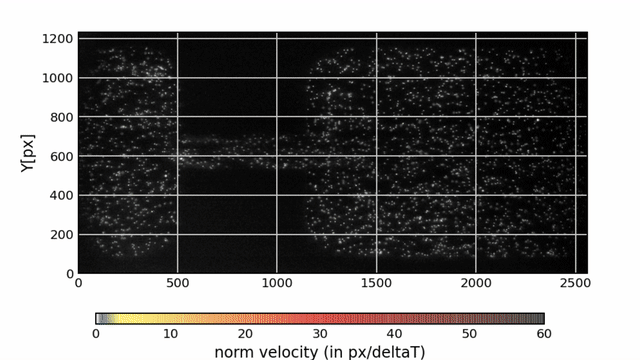opyflow
Test PIV Challenge 2014 - Case A
Starting
It is important to build a correct work tree for performing the analysis by defining where you will save your outputs and in which folder your process is performed
import os, sys
import opyf
folder_main='.'
# change the working directory
os.chdir(folder_main)
# where are the images?
folder_src = folder_main + '/images/'
# Create a folder to save outputs (csv files, vtk files, hdf5 files, images)
folder_outputs = folder_main+'/outputs'
opyf.mkdir2(folder_outputs)
Build the Analyzer object
Now, you may build an Analyzer object from your frame sequence containing both the information of the sequence and all the parameter for the velocimetry processing and post-processing (optical flow, filters and targeted resolution for the grid to interpolate on).
Because the PIV Challenge have a specific format (tiff) it is required to define the imreadOption=2 (equivalent to the option cv2.IMREAD_ANYDEPTH), to load the correct values for each pixel. Also, the range of pixels must be set (here,rangeOfPixels=[450, 900])
frames = opyf.frameSequenceAnalyzer(folder_src,
imreadOption=2,
rangeOfPixels=[450, 900],
vlim=[2,60])
set the displacement limits expected between images (here between 2 and 90 px).
frames.set_vlim([2,90])
Another important parameter is the filter wayBackGoodFlag which id a filter based on the calculation of the displacement from image A to image B and from B to image A and then evaluate if the way back is located on the initial position. wayBackGoodFlag=1 specifies that the difference between the initial position and the way back is one.
frames.set_filtersParams(wayBackGoodFlag=1)
Run the analysis
Good features to track and displacements
frames.extractGoodFeaturesAndDisplacements()

- Save your displacements if wanted (in csv or hdf5)
frames.writeGoodFeaturesPositionsAndDisplacements(fileFormat='csv', outFolder=folder_outputs)
Good features to track, displacements and interpolation on a field
frames.extractGoodFeaturesPositionsDisplacementsAndInterpolate()

- Save your field if wanted (in csv or hdf5)
frames.writeVelocityField(fileFormat='csv')
Mask
A mask to discard some regions of the frames can be applied
For the PIV Challenge 2014 case A, a mask has been produced previously and is available in the PIV Challenge test folder. The mask can be set when defining the analyzer object or simply using the set_mask option.
frames = opyf.frameSequenceAnalyzer(folder_src, imreadOption=2, rangeOfPixels=[450, 900], vlim=[2, 60], mask=folder_main+'/mask.tiff')
Or if the frame ocject has already been produced:
frames.set_mask(folder_main + '/mask.tiff')
Performing the velocimetry analysis on the entire dataset
If you loaded the entire dataset, you may run the code bellow (only the 2 first frames are in the images folder, it is required to download the entire dataset on the PIV Challenge website - Case A)
It is important to specify the number of frames and the shift (here 2 because the frame sequence is constituted of image pairs). The step parameter is the number of frame spacing the displacements measure (for pair of images it is very often 1).
frames.set_vecTime(Ntot=600,shift=2,step=1)

For technical details on the procedure feel free to check the Annex B of Turbulent flows over rough permeable beds.